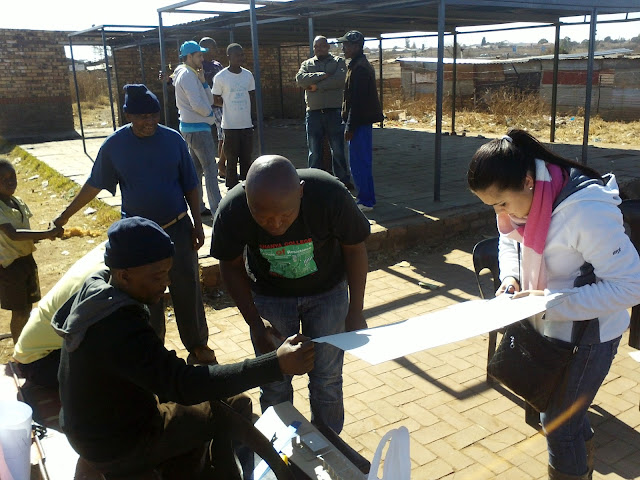Slovo Park at a Glance
Slovo Park is situated in a politically and socially sensitive stretch of land south of Soweto. The community has been known by national government as Nancefield, by local council as Olifantsvlei and in the last five years as Slovo Park – named in honour of South Africa’s first minister of housing and former Umkhonto we Sizwe General, Joe Slovo.
The forced changing of identity reflects an on-going struggle faced by the leadership of Slovo Park to gain recognition as a legitimate settlement to access governmental support. This battle has been fought through constant shifts in governmental policy, power and promises for the community of Slovo Park. Their only tactics comprising of service delivery protest, painstaking formal requests for upgrade and currently a lawsuit against the City of Johannesburg.
Currently the community of Slovo Park with its development partners are strategizing this key social and political move.
THIS SITE SERVES AS A PORTAL FOR THE COMMUNITY OF SLOVO PARK & THE VARIOUS DEVELOPMENT PARTNERS TO SHARE THE JOURNEY OF RE-DEVELOPMENT.

NEWSFEED
Saturday, June 30, 2012
Interactive Design Workshop
Wednesday, June 27, 2012
Business Forum Meeting
To not disturb the Forum meeting any further, we proceeded to Frank Mapara's tavern, where we finalized Saturday's agenda and got ideas regarding the children's level of involvement and possible fun activities to introduce during the course of our engagements.
Our meeting gave us a clear vision for the next session and got us excited about the workshop planned for Saturday.
Sunday, June 24, 2012
Presentations at Maparas
Fortunately for us, Frank Mapara had a wooden fire ready and waiting for us when we met with him, the other members of the Business forum and representatives from the Youth forum, at his tavern on Sunday Morning.
The 2012 Slovo 2.0 student research group realised that the long term vision for Slovo Park was to ensure that the community become self-empowered and independent from surrounding communities and government aid. This was informed by meetings with the Slovo Community forum and the Business forum. Thorough research completed and made available by the 2010 student group, established a solid foundation for brainstorming and designing relevant architectural interventions. These focused on addressing the problems which prevented the community from achieving self-sustainability. More importantly, the students recognised the existing opportunities which would aid Slovo Park in reaching their long term goal.
The purpose of the meeting on Sunday was for the students to share their ideas with the community about how they believe Slovo Park can become self-sustaining in the long term. The residents which were present at the meeting analysed each design programme and made suggestions about which ideas would be viable for the long term goal and which would be the easiest to implement.
They responded well (much better than our lecturers did) to all concepts concerning farming
and rehabilitation of the river. This first project, by Kiana, dealt with flooding prevention, urban farming and biogas production. It was highly welcomed, as yesterday, a body was found lying dead in the river. The resultant negative connotations associated with the river prevent any farming commitment from community members.
Following on from Kiana was Abby’s composting worm farm landscape, which contributed to the self-sustaining farming production proposed for Slovo Park. This was highly favoured, as it deals with managing composting and fertilizer production on a residential scale, and when appropriate, can be expanded to a commercial scale, utilizing the large and vacant space on Eloff street. Recreation and children’s play areas would be incorporated in this landscape.
The depot, proposed by Carla, was inspired by a meeting with Buccs, the Business forum leader. He spoke of their desire to purchase the WILCO industrial building adjacent to Slovo Park to use as storage and refrigeration of bulk goods. Although her ideas were well received, they informed us of new developments which suggest that the property has been reallocated. Fortunately, there are alternative vacant properties which can adopt this programme.
The concept of a bridge market, proposed by Ingmar, was highly favoured in the hopes that it can alleviate the current high crime situation by increasing activity, instigated by the existing market condition.
Re-appropriated busses, proposed by Tuliza, raised concerns about the time frame that re-
appropriated busses could be completed and implemented. They mentioned that if had appropriate funding and ownership, it would be essential in gaining external interest and revenue.
“There’s a baby being made everyday in Slovo Park, haha”: Mohau
This statement reaffirmed the relevance of Yolandi’s crèche in Slovo Hall. Her proposal aims to establish an internet café and play route, in the hopes of having constant learning and recreational activity available for the children of Slovo. Constant activity in the space not only limits crime and establishes surveillance in that open space, but keeps the children preoccupied and less involved in criminal activities. Dan jokingly referred to it as Slovo’s Sandton city, but overall, saw the relevance of addressing the children’s needs.
The final project presented to them, dealt with sports and recreation at Slovo Hall, proposed by Omar. It aims to extend the repertoire of sports currently available, with the inclusion of some much needed facilities. It was well received, as again, it addressed a pertinent issue, but problems arose regarding funding.


















